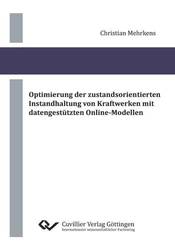| Departments | |
|---|---|
| Book Series (96) |
1378
|
| Nachhaltigkeit |
3
|
| Gesundheitswesen |
1
|
| Humanities |
2364
|
| Natural Sciences |
5406
|
| Engineering |
1793
|
| Engineering | 292 |
| Mechanical and process engineering | 862 |
| Electrical engineering | 686 |
| Mining and metallurgy | 30 |
| Architecture and civil engineering | 75 |
| Common |
98
|
|
Leitlinien Unfallchirurgie
5. Auflage bestellen |
|
Advanced Search
Optimierung der zustandsorientierten Instandhaltung von Kraftwerken mit datengestützten Online-Modellen (English shop)
Christian Mehrkens (Author)Preview
Extract, PDF (250 KB)
Table of Contents, PDF (80 KB)
Infolge des hohen Kostendrucks wird es für Kraftwerksbetreiber zunehmend wichtiger, ihre Anlagen in jedem geforderten Lastpunkt optimal zu betreiben und Abweichungen vom Sollzustand frühzeitig zu erkennen. In dieser Arbeit wird eine einheitliche und übertragbare Methodik für den Entwurf und die Implementierung von Gütegraden zur Online-Zustandsüberwachung unterschiedlicher Komponenten in Kraftwerken auf Basis von künstlichen Neuronalen Netzen vorgestellt. Durch Extrapolation des zeitlichen Gütegrad- oder Kostenverlaufs infolge der Zustandsverschlechterung ist es möglich, den optimalen Instandhaltungszeitpunkt einer Komponente zu bestimmen.
To minimise costs, it is important to operate power plants optimally at every load requested. For this reason, an early detection of deviations is necessary. In this work, a unified and transferable methodology is introduced for the development and implementation of performance indicators. Based on artificial neural networks, these indicators are used for online condition monitoring. By extrapolating the performance indicator or cost trend due to degradation, it is possible to determine the optimum time for maintenance for the associated component.
| ISBN-13 (Hard Copy) | 9783954043040 |
| ISBN-13 (eBook) | 9783736943049 |
| Final Book Format | A5 |
| Language | German |
| Page Number | 178 |
| Lamination of Cover | matt |
| Edition | 1. Aufl. |
| Publication Place | Göttingen |
| Place of Dissertation | Hamburg-Harburg |
| Publication Date | 2012-12-11 |
| General Categorization | Dissertation |
| Departments |
Engineering
Mechanical and process engineering |
| Keywords | Energietechnik, Kraftwerk, Gütegrad, Optimierung, Instandhaltung, künstliche neuronale Netze |








